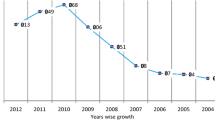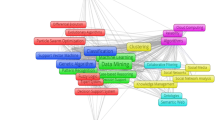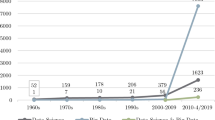Abstract
Conferences play a major role for the development of scientific domains. While journal and article contributions in the field of international business (IB) are a general and well researched area of scientometric studies, conferences are not. The absence of a systematic assessment of international business conferences as a reference to the collective status of the Academy of International Business (AIB) community is astonishing. Whatever reasons are accountable for that fact, this paper starts to fill that gap. It establishes a knowledge network composed of the last six years AIB conferences. We collected all the contributions in full text with their abstracts and keywords from 2006 to 2011. All the data have been organized in a data system and we used the information-theoretic clustering method which allows different analytical views through the entire knowledge corpus. The results indicate significant statistical differences between topic modules and keyword threads of the yearly conferences. There are three keywords which dominate as a leitmotif between 2006 and 2011, but the detailed structure changes from conference to conference significantly.


Similar content being viewed by others
References
An, X. Y., & Wu, Q. Q. (2011). Co-word analysis of the trends in stem cells field based on subject heading weighting. Scientometrics, 88(1), 133–144.
Artto, K., Martinsuo, M., Gemunden, H. G., & Murtoaro, J. (2009). Foundations of program management: a bibliometric view. International Journal of Project Management, 27(1), 1–18.
Bech, M. L., Bergstrom, C. T., Garratt, R., & Rosvall, M. (2011). Mapping change in the federal funds market. Working Paper, available at SSRN: http://ssrn.com/abstract=1917412.
Bettencourt, L. M., Kaiser, D. I., & Kaur, J. (2009). Scientific discovery and topological transitions in collaboration networks. Journal of Informetrics, 3(3), 210–221.
Bilgin, F. Z., Sriram, V., & Wuehrer, G. A. (Eds.). (2004). Drivers of global business success. Lessons from emerging markets. Basingstoke: Palgrave Macmillan.
Bilgin, F. Z., & Wuehrer, G. A. (2007). Trends in the field of scholarly marketing in Turkey: a scientometric review of 25 years of Master and Ph.D. thesis work. http://citeseerx.ist.psu.edu/viewdoc/download?doi=10.1.1.140.3912&rep=rep1&type=pdf. Accessed 25 Jan 2012.
Bohne, T., Rönnau, S., & Borghoff, U. M. (2011). Efficient keyword extraction for meaningful document perception. DocEng ‘11 Proceedings of the 11th ACM symposium on Document engineering. doi: 10.1145/2034691.2034732.
Borghans, L. (2003). Why do researchers go to a conference? Discussion paper, Research Centre for Education and the Labour Market (ROA), Maastricht University, Mimeo, Maastricht.
Borghans, L., Romans, M., & Sauermann, J. (2010). What makes a good conference? Analysing the preferences of labour economists. Labour Economics, 17(5), 868–874.
Börner, K., Chen, C., & Boyack, K. (2003). Visualizing knowledge domains. Annual Review of Information Science and Technology, 37(1), 179–255.
Bornmann, L. (2011). Mimicry in science? Scientometrics, 86(1), 173–177.
Boyack, K. W., Börner, K., & Klavans, R. (2009). Mapping the structure and evolution of chemistry research. Scientometrics, 79(1), 45–60.
Buckley, P. J. (2002). Is the international business research agenda running out of steam? Journal of International Business Studies, 33(2), 365–373.
Butler, L., & Visser, M. S. (2006). Extending citation analysis to non-source items. Scientometrics, 66(2), 327–343.
Camarinha-Matos, L. M., & Afsarmanesh, H. (2005). Collaborative networks: a new scientific discipline. Journal of Intelligent Manufacturing, 16(4–5), 439–452.
Chabowski, B. R., Hult, G. T. M., Kiyak, T., & Mena, J. A. (2009). The structure of JIBS’s social network and the relevance of intra-country variation: a typology for future research. Journal of International Business Studies, 41(5), 925–934.
Chabowski, B. R., Mena, J. A., & Gonzalez-Padron, T. L. (2011). The structure of sustainability research in marketing, 1958–2008: a basis for future research opportunities. Journal of the Academy of Marketing Science, 39(1), 55–70.
Chambers, D., Roberts, S., & Lewis-Cameron, A. (2010). Papers from conference proceedings of the 1st international tourism conference—‘beyond the boundary: creating new epistemologies in tourism’. Tourism and Hospitality Research, 10(4), 311–314.
Chen, C. (2003). Mapping scientific frontiers. The quest for knowledge visualization. London; New York: Springer.
Cobo, M. J., López-Herrera, A. G., Herrera-Viedma, E., & Herrera, F. (2011). An approach for detecting, quantifying, and visualizing the evolution of a research field: a practical application to the Fuzzy sets theory field. Journal of Informetrics, 5(1), 146–166.
Cronin, B. (1984). The citation process. London: Taylor Graham.
Ding, Y., Chowdhury, G. B., & Foo, S. (2001). Bibliometric cartography of information retrieval research by using co-word analysis. Information Processing and Management, 37(6), 817–842.
DuBois, F. L., & Reeb, D. (2000). Ranking the international business journals. Journal of International Business Studies, 31(4), 689–704.
Dunning, J. H. (2007). A new Zeitgeist for international business activity and scholarship. European Journal of International Management, 1(4), 278–300.
Efron, B., & Tibshirani, R. J. (1998). An introduction to the bootstrap. Boca Raton: Chapman & Hall.
Franceschet, M. (2010). The difference between popularity and prestige in the sciences and in the social sciences: a bibliometric analysis. Journal of Informetrics, 4(1), 55–63.
Gingras, Y., & Wallace, M. L. (2010). Why it has become more difficult to predict Nobel prize winners: a bibliometric analysis of nominees and winners of the chemistry and physics prizes (1901–2007). Scientometrics, 82(2), 401–412.
Glänzel, W., Schlemmer, B., Schubert, A., & Thijs, B. (2006). Proceedings literature as additional data source for bibliometric analysis. Scientometrics, 68(3), 457–473.
González-Albo, B., & Bordons, M. (2011). Articles vs. proceedings papers: do they differ in research relevance and impact? A case study in the library and information science field. Journal of Informetrics, 5(3), 369–381.
Griffith, D. A., Tamer Cavusgil, S., & Elgar, E. (2008). Emerging themes in international business research. Journal of International Business Studies, 39(7), 1220–1235.
Halpern, J. Y., & Parkes, D. C. (2011). Journals for certification, conferences for rapid dissemination. Communications of the ACM, 54(8), 36–38.
Hofer, K. M., Smejkal, A. E., Bilgin, F. Z., & Wuehrer, G. A. (2010). Conference proceedings as a matter of bibliometric studies: the academy of international business 2006–2008. Scientometrics, 84(3), 845–862.
Íñiguez-Rueda, L., Martínez-Martínez, L. M., Muñoz-Justicia, J. M., Peñaranda-Cólera, M. C., Sahagún-Padilla, M. A., & Alvarado, J. G. (2008). The mapping of Spanish social psychology through its conferences: a bibliometric perspective. The Spanish Journal of Psychology, 11(1), 137–158.
Kara, S., Alan, Ö., Sabuncu, O., Akpinar, S., Cicekli, N. K., & Alpaslan, F. N. (2012). An ontology-based retrieval system using semantic indexing. Information Systems Management, 37(4), 294–305.
Kim, H., Yoon, J. W., & Crowcroft, J. (2012). Network analysis of temporal trends in scholarly research productivity. Journal of Informetrics, 6(1), 97–110.
Kuhn, T. S. (2009). The structure of scientific revolutions. Chicago: University of Chicago Press.
Lahiri, S., & Kumar, V. (2012). Ranking international business institutions and faculty members using research publication as the measure: update and extension of prior research. Accepted Paper Series, available at SSRN: http://ssrn.com/abstract=1768026.
Leonidou, L. C., Katsikeas, C. S., & Coudounaris, D. N. (2010). Five decades of business research into exporting: a bibliographic analysis. Journal of International Management, 16(1), 78–91.
Leskovec, J., Kleinberg, J, & Faloutsos, C. (2005). Graphs over time: densification laws, shrinking diameters and possible explanations. KDD’05 Proceedings of the eleventh ACM SIGKDD international conference on knowledge discovery data mining. doi:10.1145/1081870.1081893.
Leximancer. (2009). Leximancer: The why, not just the what. Leximancer Manual, Version 3.07. Brisbane: QLD: Leximancer Pty. Ltd and The University of Queensland.
Leydesdorff, L. (2001). The challenge of scientometrics. The development, measurement, and self-organization of scientific communications. Parkland, Ill: Universal Publication.
Leydesdorff, L. (2012). Advances in science visualization. Social networks, semantic maps, and discursive knowledge. http://arxiv.org/ftp/arxiv/papers/1206/1206.3746.pdf. Accessed 8 Oct 2012.
Liesch, P. W., Håkanson, L., McGaughey, S. L., Middleton, S., & Cretchley, J. (2011). The evolution of the international business field: a scientometric investigation of articles published in its premier journal. Scientometrics, 88(1), 17–42.
Lisée, C., Larivière, V., & Archambault, É. (2008). Conference proceedings as a source of scientific information: a bibliometric analysis. Journal of the American Society for Information Science and Technology, 59(11), 1776–1784.
Muñoz-Leiva, F., Viedma-del-Jesús, M. I., Sánchez-Fernández, J., & López-Herrera, A. G. (2011). An application of co-word analysis and bibliometric maps for detecting the most highlighting themes in the consumer behaviour research from a longitudinal perspective. Quality & Quantity. doi:10.1007/s11135-011-9565-3.
Newman, M. E. J. (2011). Communities, modules and large-scale structure in networks. Nature Physics, 8(1), 25–31.
Noyons, E. C. M. (1999). Bibliometric mapping as a science policy and research management tool. Leiden: DSWO Press.
Peng, M. W. (2004). Identifying the big question in international business research. Journal of International Business Studies, 35(2), 99–108.
Rokaya, M., Atlam, E., Fuketa, M., Dorji, T. C., & Aoe, J. i. (2008). Ranking of field association terms using co-word analysis. Information Processing and Management, 44(2), 738–755.
Rosvall, M., Axelsson, D., & Bergstrom, C. T. (2009). The map equation. http://arxiv.org/PS_cache/arxiv/pdf/0906/0906.1405v2.pdf. Accessed 6 Mar 2012.
Rosvall, M., & Bergström, C. T. (2008). Maps of random walks on complex networks reveal community structure. PNAS, 105(4), 1118–1123.
Rosvall, M., Bergstrom, C. T., & Rapallo, F. (2010). Mapping change in large networks. PLoS ONE, 5(1), 1–7.
Rosvall, M., Bergstrom, C. T., & Rapallo, F. (2011). Multilevel compression of random walks on networks reveals hierarchical organization in large integrated systems. PLoS ONE, 6(4), 1–10.
Rowley-Jolivet, E. (1999). The pivotal role of conference papers in the network of scientific communication. ASP online 23–26, 1999. doi:10.4000/asp.
Samiee, S., & Chabowski, B. R. (2011). Knowledge structure in international marketing: a multi-method bibliometric analysis. Journal of the Academy of Marketing Science, 40(2), 364–386.
Serenko, A., Cox, R. A., Bontisc, N., & Booker, L. D. (2011). The superstar phenomenon in the knowledge management and intellectual capital academic discipline. Journal of Informetrics, 5(3), 333–345.
Sidiropoulos, A., & Manolopoulos, Y. (2005). A new perspective to automatically rank scientific conferences using digital libraries. Information Processing and Management, 41(2), 289–312.
Sullivan, D., Nerur, S. P., & Balijepally, V. (2010). Source or storer? IB’s performance in a knowledge network. Journal of International Business Studies, 42(3), 446–457.
Treviño, L. J., Mixon, F. G. Jr, Funk, C. A., & Inkpen, A. C. (2010). A perspective on the state of the field: international business publications in the elite journals as a measure of institutional and faculty productivity. International Business Review, 19(4), 378–387.
Uysal, Ö. Ö. (2010). Business ethics research with an accounting focus: a bibliometric analysis from 1988 to 2007. Journal of Business Ethics, 93(1), 137–160.
van Eck, N. J. (2011). Methodological advances in bibliometric mapping of science. http://repub.eur.nl/res/pub/26509/EPS2011247LIS9789058922915.pdf. Accessed 25 Jan 2012.
van Eck, N. J., & Waltman, L. (2007). Bibliometric mapping of the computational intelligence field. International Journal of Uncertainty, Fuzziness and Knowledge-Based Systems, 15(5), 625–645.
van Eck, N. J., & Waltman, L. (2011). Text mining and visualization using VOSviewer. ISSI Newsletter, 7(3), 50–54.
Watts, D. J., & Strogatz, S. H. (1998). Collective dynamics of ‘small-world’ networks. Nature, 393(4), 440–442.
Williams, B., & Plouffee, C. (2007). Assessing the evolution of sales knowledge: a 20-year content analysis. Industrial Marketing Management, 36(4), 408–419.
Wilson, D., & McKiernan, P. (2011). Global mimicry: putting strategic choice back on the business school agenda. British Journal of Management, 22(3), 457–469.
Wuehrer, G. A., Bilgin, Z. F., & Karaosmanoglu, E. (2011). The development and transfer of scholarly marketing thought in Turkey: a scientometric analysis of Master and Ph.D. thesis 1980–2008 in an emerging market country. http://beykon.org/foto2010/33.pdf. Accessed 25 Jan 2012.
Yoon, B., Lee, S., & Lee, G. (2010). Development and application of a keyword-based knowledge map for effective R&D planning. Scientometrics, 85(3), 803–820.
Zhang, L., & Glänzel, W. (2012). Proceeding papers in journals versus the “regular” journal publications. Journal of Informetrics, 6(1), 88–96.
Author information
Authors and Affiliations
Corresponding author
Rights and permissions
About this article
Cite this article
Wuehrer, G.A., Smejkal, A.E. The knowledge domain of the academy of international business studies (AIB) conferences: a longitudinal scientometric perspective for the years 2006–2011. Scientometrics 95, 541–561 (2013). https://doi.org/10.1007/s11192-012-0909-0
Received:
Published:
Issue Date:
DOI: https://doi.org/10.1007/s11192-012-0909-0




